 National High-Tech Enterprise
National High-Tech Enterprise
 WhatsApp
WhatsApp
 Pyrolysis Plant For Sale from TOP Manufacturer
Pyrolysis Plant For Sale from TOP Manufacturer
 National High-Tech Enterprise
National High-Tech Enterprise

 November 18, 2025
November 18, 2025Combustion, gasification, and pyrolysis each transform materials—but their approaches and outcomes differ dramatically. While combustion fully consumes fuel for heat, and gasification partially breaks it down into syngas, pyrolysis thermally decomposes materials without oxygen, creating valuable products like pyrolysis oil and carbon black.
Combustion, commonly known as burning, is the most straightforward thermochemical process. It involves the reaction of fuel with an abundant supply of oxygen. The primary goal is to fully oxidize the carbon and hydrogen content in the fuel, thereby releasing the maximum amount of energy in the form of heat.
The main outputs are heat, carbon dioxide, and water vapor. The exhaust gas, or flue gas, also contains nitrogen and potential pollutants like sulfur oxides, nitrogen oxides, and particulate matter.
Combustion is highly efficient for direct heat and electricity generation. However, it offers little opportunity for material recovery, as the fuel is fully consumed. It's commonly used in industrial furnaces, and waste-to-energy incinerators, but it can contribute to greenhouse gas emissions if not equipped with emission controls. While straightforward, combustion's reliance on complete burning limits its versatility for resource recovery.
Gasification is a partial oxidation process. The fuel is heated with a controlled and limited amount of oxygen, which is intentionally less than the amount required for complete combustion. This process breaks down complex hydrocarbons into a mixture of combustible gases.
The primary output is syngas, a versatile mixture mainly composed of carbon monoxide and hydrogen with traces of methane, CO₂, and other gases.
Gasification is more efficient for fuel conversion than combustion, while producing a cleaner, gaseous fuel from solids. It reduces emissions compared to direct burning and is ideal for integrated gasification combined cycle power plants, chemical production, and converting coal or biomass into hydrogen. However, it requires sophisticated equipment to handle tar and impurities in the syngas. Gasification's partial oxidation makes it a stepping stone toward cleaner energy from solid fuels, emphasizing gas production over mere heat.
Pyrolysis is a thermochemical process that decomposes organic materials through intense heat in a complete absence of oxygen. The intense heat causes the fuel's chemical bonds to break without combustion, resulting in solid, liquid, and gaseous products. This method is particularly valuable for waste valorization, as it preserves more of the material's chemical structure for reuse.
The process yields three main fractions:
Carbon Black: A solid, carbonaceous material. Carbon Black can be used for activated carbon production, or as a reinforcing filler in industries like tire manufacturing, where it improves rubber's durability and strength and as a pigment in inks, paints, and plastics.
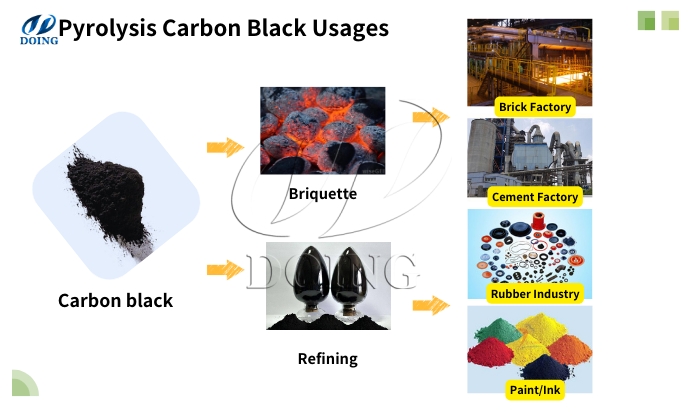
Pyrolysis carbon black usages
Pyrolysis Oil: A dark, viscous oil comprising 40-60% of the output, rich in phenolic compounds and hydrocarbons. Pyrolysis oil serves as an alternative fuel for boilers or engines, generating heat or mechanical power, and can be further refined into usable fuels like diesel for generators and heavy machinery.
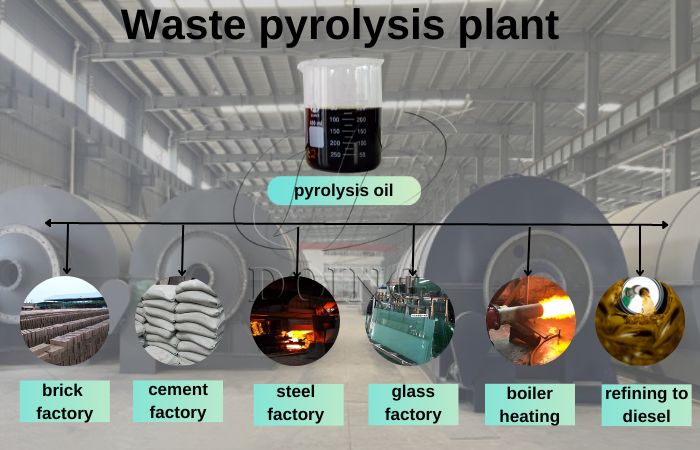
Applications of waste pyrolysis oil
Syngas: A non-condensable gas mixture. Primarily, syngas is used on-site to provide the heat required for the pyrolysis reactor itself, enabling energy self-sufficiency and reducing operational costs without external fuel inputs.

DOING pyrolysis machine syngas recycling system
The core advantage of pyrolysis lies in its ability to transform complex organic waste into a variety of high-value-added products, thus "turning waste into treasure." It demonstrates enormous application potential in the field of waste resource utilization.
The brief difference can be described through the following analogy:
Combustion is like a campfire – you burn something completely to get heat.
Gasification is like a charcoal grill – you limit air to create a flammable gas (and heat).
Pyrolysis is like baking in an oven – you use heat in the complete absence of air to break the material apart.
| Feature | Combustion | Gasification | Pyrolysis |
| Oxygen | Excess | Controlled, Limited | Absent |
| Process | Complete Oxidation | Partial Oxidation | Thermal Decomposition |
| Primary Goal | Heat Generation | Clean gas fuel | Energy Conversion |
| Main Products | CO₂, H₂O, Heat | CO, H₂ (Syngas) | Pyrolysis Oil, Carbon black, Syngas |
| Material Recovery | None | Low | High |
| Characteristic | The process is simple, but there is a risk of pollution. | The product has high cleanliness, but it requires high input of raw materials and technology. | High overall cost performance, diverse raw materials, and meets safety and environmental protection standards. |
These distinctions make pyrolysis particularly appealing for modern waste management, where environmental sustainability is key.
Building on these processes, pyrolysis stands out in waste recycling due to its ability to handle diverse feedstocks without the emissions of combustion or the oxygen needs of gasification.
Diversity of Feedstocks: Pyrolysis technology processes a wide range of waste materials, including waste tires, plastic scrap, oil sludge, municipal solid waste, agricultural residues, and even medical waste.

DOING pyrolysis machine feedstocks
Overview of Pyrolysis Equipment: A typical pyrolysis plant consists of a reactor (batch, semi-continuous, or fully continuous), feeding system, condenser for oil collection, gas cleaning unit, and carbon black discharge mechanism. Our DOING pyrolysis machines operate at controlled temperatures under vacuum atmosphere, with capacities from 100kg-50 tons per day. The system integrates syngas recycling for self-heating, minimizing energy use, and includes like PLC control system and exhaust gas purification device to meet environmental standards.
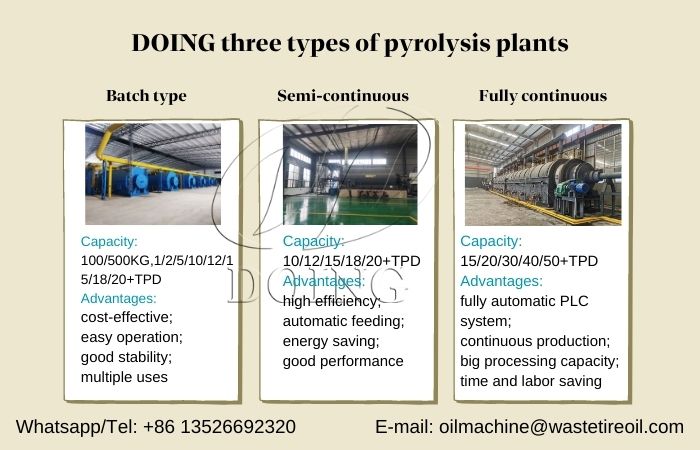
DOING pyrolysis machine types
Advantages of Pyrolysis: This technology offers superior environmental and economic benefits. It reduces landfill waste by up to 90%, prevents open burning pollution, and produces high-value outputs—pyrolysis oil for fuel, carbon black for industrial use, and syngas for process efficiency. Compared to incineration, it lowers CO₂ emissions by avoiding full oxidation. Economically, it turns waste into revenue streams, with ROI often achieved in 2-3 years through product sales. For industries dealing with waste tires or plastics, pyrolysis provides a clean, scalable and profitable solution for resource recovery.
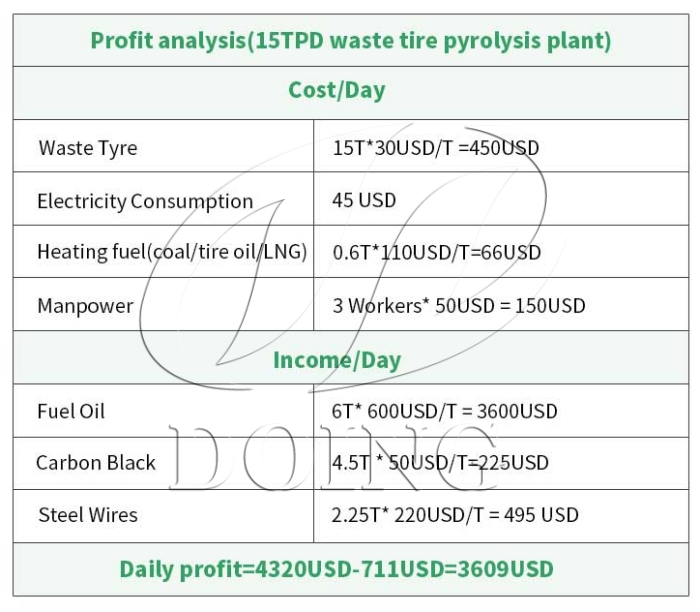
Profit analysis of 15TPD waste tire pyrolysis machine
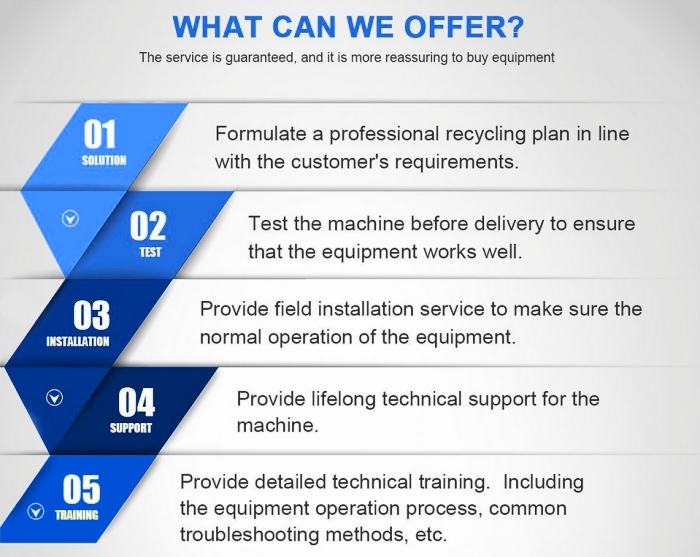
DOING pyrolysis machine manufacturer
If you're interested in how pyrolysis can address your waste challenges, feel free to contact DOING Company for tailored inquiries or demonstrations. We're here to help educate and implement pyrolysis technologies.
Please feel free to leave your contacts here and your privacy is protected. A competitive quotation will be provided according to your detailed requirement within one business day.